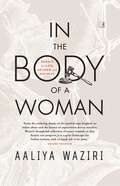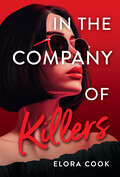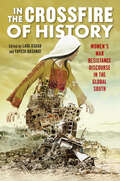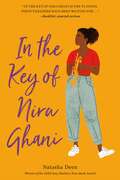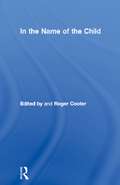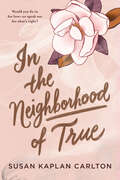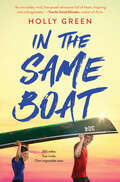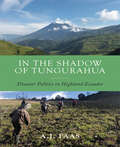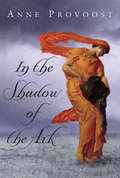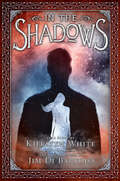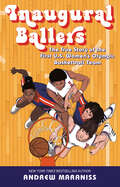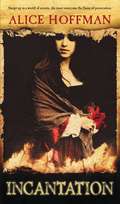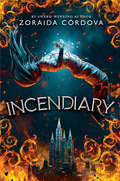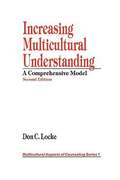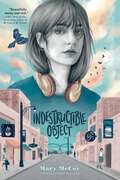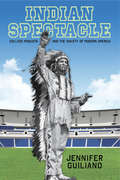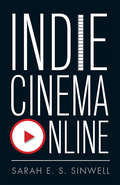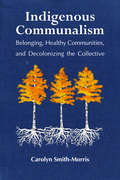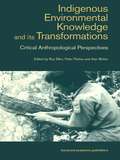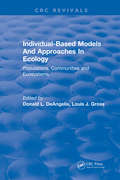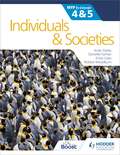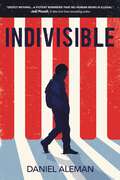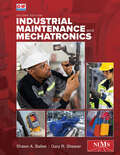- Table View
- List View
In the Body of a Woman: Essays on Law, Gender and Society
by Aaliya Waziri&‘From the enduring shame of the marital-rape loophole to online abuse and the horror of superstition-driven murders, Waziri&’s thoughtful collection of essays reminds us that despite our progress, it is a grim landscape for Indian women, with so much left to be done.&’ SHASHI THAROOR &‘The author brilliantly lays bare for the reader the emergent, new societal responses towards sexual attitudes and gender justice and competently captures with nuance and sensitivity the attempts of the legal system to keep pace without being overwhelmed.&’ SALMAN KHURSHID &‘An incisive and mindful analysis of gender and parity through the intersection of legal frameworks and societal perspectives. Aaliya Waziri draws upon a vast canvas to present an articulate and thoughtful case for gender-responsive lawmaking.&’ NAMITA GOKHALE From important contemporary issues like the changing landscape of marital rape laws to the inadequacy of the current cyberbullying laws, from historical milestones such as the women who helped draft the Indian constitution after Independence to examining religious laws and international obligations, Aaliya Waziri writes a deeply researched, informative and powerful book. Her attempt is to address the many questions that a lay person or even a lawyer might have about what lies at the intersection of law, gender and society.In the Body of a Woman, with its focus on gender justice, pivots on the idea that feminism is contextual. There may not be any straightjacket formula to fix all the woes of women but we can start by strengthening our institutional responses and not treat half the country&’s population as second class citizens. Occasionally acerbic yet deeply compassionate, hopeful yet sometimes despairing, Waziri doesn&’t pull her punches in these essays where she looks clinically at the judicial system but in her own unique, empathetic way that makes this book an engaging read for—it must be stressed—men and women who are interested in probing the intersection of law and gender.
In the Company of Killers
by Elora CookGossip Girl meets The Sopranos in this fast-paced drama about a teenage mafia heiress who would do anything to avenge her family, even join forces with her handsome enemy. Inside the tony suburb of Scarsdale is New York&’s worst-kept secret: The mob runs everything, and the Nicastro family is at the center. Seventeen-year-old Tasha Nicastro lives a life of glitz and glamour, but she has no idea her family harbors a dark truth. Tasha might look like your classic high school mean girl, but behind the designer clothes is a sharpshooter who knows how to bring anyone to their knees. The only person who has ever gotten under her skin is her former best friend, Leo Danesi, the youngest son of the Nicastro family&’s rivals. After Leo returns to New York older and more handsome, Tasha thinks he&’ll be the worst of her problems—until the life she thought she knew takes a violent, shocking turn. When her father and beloved older sister are murdered before her eyes, Tasha learns the dark truth: Her family runs the most powerful Mafia branch in New York, and now she&’s set to inherit it all. Tasha vows vengeance on the mysterious new mob behind the hit, but she can&’t do it alone. She needs someone who already knows the underground world to help track them down. And that person is none other than Leo, the heir to his own family&’s dangerous empire. But Tasha is a Nicastro. She&’s been raised in the company of killers, and there&’s absolutely nothing she won&’t do to avenge her family. That is, if the enemy doesn&’t put her in gold chains first. Perfect for fans of:Mafia RomancesSecond Chance RomanceRivals-to-LoversThrillersMysteries
In the Crossfire of History: Women's War Resistance Discourse in the Global South (War Culture)
by Matthew Spencer Lava Asaad Doaa Omran Farzana Akhter Margaret Hageman Nyla Khan Shafinur Nahar Carolyn Ownbey Moumin Quazi Lucia Garcia-Santana Stefanie SevcikIn the global south, women have and continue to resist multiple forms of structural violence. The atrocities committed against Yazidi women by ISIS have been recognized internationally, and the Nobel Peace Prize awarded to Nadia Murad in 2018 was a tribute to honor women whose bodies have been battered in the name of race, nationality, war, and religion. In the Crossfire of History:Women's War Resistance Discourse in the Global South is an edited collection that incorporates literary works, testimonies, autobiographies, women’s resistance movements, and films that add to the conversation on the resilience of women in the global south. The collection focuses on Palestine, Kashmir, Syria, Kurdistan, Congo, Argentina, Central America, Sri Lanka, and Bangladesh. The essays question historical accuracy and politics of representation that usually undermine women’s role during conflict, and they reevaluate how women participated, challenged, sacrificed, and vehemently opposed war discourses that erase women’s role in shaping resistance movements. The transformative mode of these examples expands the definition of heroism and defiance. To prevent these types of heroism from slipping into the abyss of history, this collection brings forth and celebrates women’s fortitude in conflict zones. In the Crossfire of History shines a light onwomen across the globe who are resisting the sociopolitical and economic injustices in their nation-states.
In the Key of Nira Ghani
by Natasha DeenNira Ghani has always dreamed of becoming a musician. Her Guyanese parents, however, have big plans for her to become a scientist or doctor. Nira's grandmother and her best friend, Emily, are the only people who seem to truly understand her desire to establish an identity outside of the one imposed on Nira by her parents. When auditions for jazz band are announced, Nira realizes it's now or never to convince her parents that she deserves a chance to pursue her passion. <p><p> As if fighting with her parents weren't bad enough, Nira finds herself navigating a new friendship dynamic when her crush, Noah, and notorious mean-girl, McKenzie "Mac," take a sudden interest in her and Emily, inserting themselves into the fold. So, too, does Nira's much cooler (and very competitive) cousin Farah. Is she trying to wiggle her way into the new group to get closer to Noah? Is McKenzie trying to steal Emily's attention away from her? As Farah and Noah grow closer and Emily begins to pull away, Nira's trusted trumpet "George" remains her constant, offering her an escape from family and school drama. <p> But it isn't until Nira takes a step back that she realizes she's not the only one struggling to find her place in the world. As painful truths about her family are revealed, Nira learns to accept people for who they are and to open herself in ways she never thought possible. <p> A relatable and timely contemporary, coming-of age story, In the Key of Nira Ghani explores the social and cultural struggles of a teen in an immigrant household.
In the Name of the Child (Routledge Studies in the Social History of Medicine)
by Roger CooterRecent revelations of child abuse have highlighted the need for understanding the historical background to current attitudes towards child health and welfare. In the Name of the Child explores a variety of professional, social, political and cultural constructions of the child in the decades around the First World War. It describes how medical and welfare initiatives in the name of the child were shaped and how changes in medical and welfare provisions were closely allied to political and ideological interests.
In the Neighborhood of True
by Susan Kaplan CarltonA powerful story of love, identity, and the price of fitting in or speaking out.“The story may be set in the past, but it couldn’t be a more timely reminder that true courage comes not from fitting in, but from purposefully standing out . . . and that to find out who you really are, you have to first figure out what you’re not.” —Jodi Picoult, New York Times bestselling author of A Spark of Light and Small Great Things After her father’s death, Ruth Robb and her family transplant themselves in the summer of 1958 from New York City to Atlanta—the land of debutantes, sweet tea, and the Ku Klux Klan. In her new hometown, Ruth quickly figures out she can be Jewish or she can be popular, but she can’t be both. Eager to fit in with the blond girls in the “pastel posse,” Ruth decides to hide her religion. Before she knows it, she is falling for the handsome and charming Davis and sipping Cokes with him and his friends at the all-white, all-Christian Club. Does it matter that Ruth’s mother makes her attend services at the local synagogue every week? Not as long as nobody outside her family knows the truth. At temple Ruth meets Max, who is serious and intense about the fight for social justice, and now she is caught between two worlds, two religions, and two boys. But when a violent hate crime brings the different parts of Ruth’s life into sharp conflict, she will have to choose between all she’s come to love about her new life and standing up for what she believes.
In the Same Boat
by Holly GreenIn the Same Boat is the hugely entertaining blend of romance and thrilling adventure that you never knew you needed.It's the eve of the Texas River Odyssey, and Sadie Scofield is finally ready for the 265-mile canoe race. It's three days of grueling, nonstop paddling, where every turn of the river reveals new challenges -- downed trees, poisonous snakes, alligators -- but the dangers are all worth it. Reaching the finish line is the only way for Sadie to redeem herself for last year, when one small mistake spiraled into disaster.Sadie has spent a year training, and she's ready for anything . . . except for her brother ditching her at the last minute for a better team.She has no choice but to team up with Cully, her former best friend turned worst enemy. Everything about him irritates her, from his stupid handsome face to the way he holds his paddle. But as the miles pass, the pain builds, and family secrets come to light, Sadie realizes she’ll have to work with Cully instead of against him. Last year's race was a catastrophe, but this year's race just might change her life in ways she never imagined.With an unforgettable heroine and an immersive setting, Holly Green's captivating debut promises heart-stopping action and a swoony romance that will leave you cheering.
In the Shadow Of the Poorhouse: A Social History Of Welfare In America, Tenth Anniversary Edition
by Michael B. KatzWith welfare reform a burning political issue, this special anniversary edition of the classic history of welfare in America has been revised and updated to include the latest bipartisan debates on how to "end welfare as we know it. ”In the Shadow of the Poorhouse examines the origins of social welfare, both public and private, from the days of the colonial poorhouse through the current tragedy of the homeless. The book explains why such a highly criticized system persists. Katz explores the relationship between welfare and municipal reform; the role of welfare capitalism, eugenics, and social insurance in the reorganization of the labor market; the critical connection between poverty and politics in the rise of the New Deal welfare state; and how the War on Poverty of the ’60s became the war on welfare of the ’80s.
In the Shadow of Tungurahua: Disaster Politics in Highland Ecuador
by A.J. FaasIn the Shadow of Tungurahua relates the stories of the people of Penipe, Ecuador living in and between several villages around the volcano Tungurahua and two resettlement communities built for people displaced by government operations following volcanic eruptions in 1999 and 2006. The stories take shape in ways that influence prevailing ideas about how disasters are produced and reproduced, in this case by shifting assemblages of the state first formed during Spanish colonialism attempting to settle (make “legible”) and govern Indigenous and campesino populations and places. The disasters unfolding around Tungurahua at the turn of the 21st century also provide lessons in the humanitarian politics of disaster—questions of deservingness, reproducing inequality, and the reproduction of bare life. But this is also a story of how people responded to confront hardships and craft new futures, about forms of cooperation to cope with and adapt to disaster, and the potential for locally derived disaster recovery projects and politics.
In the Shadow of the Ark
by Anne ProvoostTHE RED TENT meets GIRL WITH A PEARL EARRING in the profoundly moving tale of a young woman who survives the flood as a stowaway on Noah's Ark."And every living substance that I have made will I destroy from off the face of the earth..."When ReJana and her family reach the desert plain where the great ship is being constructed, the world has already begun to change. The waters are rising everywhere, and both people and animals are beginning to panic. This is the dramatic story of the weeks and months that follow, as the rain transforms the earth and the people come to understand the magnitude of the disaster. This is the story of one girl who stows away on the ark for love of Ham, Noah's son. This is her story of survival.
In the Shadows
by Kiersten White Jim Di BartoloFrom the remarkable imagination of acclaimed artist Jim Di Bartolo and the exquisite pen of bestselling author Kiersten White comes a spellbinding story of love, mystery, and dark conspiracy.From the remarkable imagination of acclaimed artist Jim Di Bartolo and the exquisite pen of bestselling author Kiersten White comes a spellbinding story of love, mystery, and dark conspiracy, told in an alternating narrative of words and pictures.Cora and Minnie are sisters living in a small, stifling town where strange and mysterious things occur. Their mother runs the local boarding house. Their father is gone. The woman up the hill may or may not be a witch.Thomas and Charles are brothers who've been exiled to the boarding house so Thomas can tame his ways and Charles can fight an illness that is killing him with increasing speed. Their family history is one of sorrow and guilt. They think they can escape from it . . . but they can't.Arthur is also new to the boarding house. His fate is tied to that of Cora, Minnie, Thomas, and Charles. He knows what darkness circles them, but can't say why, and doesn't even know if they can be saved.
Inaugural Ballers: The True Story of the First US Women's Olympic Basketball Team
by Andrew MaranissFrom the New York Times bestselling author of Strong Inside comes the inspirational true story of the birth of women&’s Olympic basketball at the 1976 Summer Games and the ragtag team that put US women&’s basketball on the map. Perfect for fans of Steve Sheinkin and Daniel James Brown.A League of Their Own meets Miracle in the inspirational true story of the first US Women&’s Olympic Basketball team and their unlikely rise to the top. Twenty years before women&’s soccer became an Olympic sport and two decades before the formation of the WNBA, the &’76 US women&’s basketball team laid the foundation for the incredible rise of women&’s sports in America at the youth, collegiate, Olympic, and professional levels. Though they were unknowns from small schools such as Delta State, the University of Tennessee at Martin and John F. Kennedy College of Wahoo, Nebraska, at the time of the &’76 Olympics, the American team included a roster of players who would go on to become some of the most legendary figures in the history of basketball. From Pat Head, Nancy Lieberman, Ann Meyers, Lusia Harris, coach Billie Moore, and beyond—these women took on the world and proved everyone wrong. Packed with black-and-white photos and thoroughly researched details about the beginnings of US women&’s basketball, Inaugural Ballers is the fascinating story of the women who paved the way for girls everywhere.
Incantation
by Alice HoffmanEstrella is a Marrano: During the time of the Spanish Inquisition, she is one of a community of Spanish Jews living double lives as Catholics. And she is living in a house of secrets, raised by a family who practices underground the ancient and mysterious way of wisdom known as kabbalah. When Estrella discovers her family's true identity--and her family's secrets are made public--she confronts a world she's never imagined, where new love burns and where friendship ends in flame and ash, where trust is all but vanquished and betrayal has tragic and bitter consequences. Infused with the rich context of history and faith, in her most profoundly moving work to date, Alice Hoffman's first historical novel is a transcendent journey of discovery and loss, rebirth and remembrance
Incendiary (Incendiary #1)
by Zoraida CordovaSet in a lushly drawn world inspired by Inquisition Spain, Zoraida Córdova's hotly anticipated new fantasy is an epic tale of love and revenge perfect for fans of Sabaa Tahir and Sarah J. Maas. I am Renata Convida.I have lived a hundred stolen lives. Now I live my own.Renata was only a child when she was kidnapped by the King's Justice and brought to the luxurious palace of Andalucia. As a memory thief, the rarest and most feared of the magical Moria, Renata was used by the crown to carry out the King's Wrath, a siege that resulted in the deaths of thousands of her own people. Now Renata is one of the Whispers, rebel spies working against the crown. The Whispers may have rescued Renata years ago, but she cannot escape their mistrust and hatred -- or the overpowering memories of the hundreds of souls she drained during her time in the palace. When Dez, the commander of her unit -- and the boy she's grown to love -- is taken captive by the notorious Principe Dorado, Renata must return to Andalucia and complete Dez's top secret mission herself. Can she keep her cover, even as she burns for vengeance against the brutal, enigmatic prince? Her life and the fate of the Moria depend on it. But returning to the palace stirs childhood memories long locked away. As Renata grows more deeply embedded in the politics of the royal court, she uncovers a secret in her past that could change the fate of the entire kingdom -- and end the war that has cost her everything.
Increasing Multicultural Understanding: A Comprehensive Model
by Don C. LockeLocke's book has become the flagship of the Multicultural Aspects of Counseling series--both as the most popular book in the series and as the first book published in it, reflecting accurately the many goals and dreams we had when the series was conceptualized. In this second edition, Locke has added chapters on the Jewish and the Muslim cultural contexts, with guidelines for counselors working with clients in those cultures. The other 10 chapters have been significantly updated since the 1992 first edition to include some of the extensive publi¬cations that have been written since that time.
Indestructible Object
by Mary McCoy&“Beautifully messy and real.&” —Amy Spalding, bestselling author of We Used to Be Friends Perfect for fans of What If It&’s Us and Mary H. K. Choi, this stunning coming-of-age novel from Printz Honor author Mary McCoy follows a Memphis teen whose quest to uncover the secrets of love reveals new truths about herself.For the past two years, Lee has been laser-focused on two things: her job as a sound tech at a local coffee shop and her podcast Artists in Love, which she cohosts with her boyfriend Vincent. Until he breaks up with her on the air right after graduation. When their unexpected split, the loss of her job, and her parent&’s announcement that they&’re separating coincide, Lee&’s plans, her art, and her life are thrown into turmoil. Searching for a new purpose, Lee recruits her old friend Max and new friend Risa to produce a podcast called Objects of Destruction, where they investigate whether love actually exists at all. But the deeper they get into the love stories around them, the more Lee realizes that she&’s the one who&’s been holding love at arm&’s length. And when she starts to fall for Risa, she finds she&’ll have to be more honest with herself and the people in her life to create a new love story of her own. Funny, romantic, and heartfelt, this is a story about secrets, lies, friendship, found family, an expired passport, a hidden VHS tape, fried pickles, the weird and wild city of Memphis, and, most of all, love.
Indian Spectacle
by Jennifer GuilianoAmid controversies surrounding the team mascot and brand of the Washington Redskins in the National Football League and the use of mascots by K-12 schools, Americans demonstrate an expanding sensitivity to the pejorative use of references to Native Americans by sports organizations at all levels. In Indian Spectacle, Jennifer Guiliano exposes the anxiety of American middle-class masculinity in relation to the growing commercialization of collegiate sports and the indiscriminate use of Indian identity as mascots. Indian Spectacle explores the ways in which white, middle-class Americans have consumed narratives of masculinity, race, and collegiate athletics through the lens of Indian-themed athletic identities, mascots, and music. Drawing on a cross-section of American institutions of higher education, Guiliano investigates the role of sports mascots in the big business of twentieth-century American college football in order to connect mascotry to expressions of community identity, individual belonging, stereotyped imagery, and cultural hegemony. Against a backdrop of the current level of the commercialization of collegiate sports--where the collective revenue of the fifteen highest grossing teams in Division I of the National Collegiate Athletic Association (NCAA) has well surpassed one billion dollars--Guiliano recounts the history of the creation and spread of mascots and university identities as something bound up in the spectacle of halftime performance, the growth of collegiate competition, the influence of mass media, and how athletes, coaches, band members, spectators, university alumni, faculty, and administrators, artists, writers, and members of local communities all have contributed to the dissemination of ideas of Indianness that is rarely rooted in native people's actual lives.
Indie Cinema Online
by Sarah E.S. SinwellIndie Cinema Online investigates the changing nature of contemporary American independent cinema in an era of media convergence. Focusing on the ways in which modes of production, distribution, and exhibition are shifting with the advent of online streaming, simultaneous release strategies, and web series, this book analyzes sites such as SundanceTV, YouTube, Netflix, Hulu, and other online spaces as a means of redefining independent cinema in a digital era. Analyzing the intersections among cinema studies, cultural studies, and new media studies within contemporary convergence culture, author Sarah E.S. Sinwell looks at sites of media convergence that are often ignored within most studies of digital media. Emphasizing the ways in which the forms and technologies of media culture have changed during the age of convergence, this book analyzes contemporary production, distribution, and exhibition practices as a means of examining the changing meanings of independent cinema within digital culture.
Indigeneity in Real Time: The Digital Making of Oaxacalifornia (Latinidad: Transnational Cultures in the United States)
by Ingrid KummelsLong before the COVID-19 crisis, Mexican Indigenous peoples were faced with organizing their lives from afar, between villages in the Oaxacan Sierra Norte and the urban districts of Los Angeles, as a result of unauthorized migration and the restrictive border between Mexico and the United States. By launching cutting-edge Internet radio stations and multimedia platforms and engaging as community influencers, Zapotec and Ayuujk peoples paved their own paths to a transnational lifeway during the Trump era. This meant adapting digital technology to their needs, setting up their own infrastructure, and designing new digital formats for re-organizing community life in all its facets—including illness, death and mourning, collective celebrations, sport tournaments, and political meetings—across vast distances. Author Ingrid Kummels shows how mediamakers and users in the Sierra Norte villages and in Los Angeles created a transborder media space and aligned time regimes. By networking from multiple places, they put into practice a communal way of life called Comunalidad and an indigenized American Dream—in real time.
Indigenous Communalism: Belonging, Healthy Communities, and Decolonizing the Collective
by Carolyn Smith-MorrisFrom a grandmother’s inter-generational care to the strategic and slow consensus work of elected tribal leaders, Indigenous community builders perform the daily work of culture and communalism. Indigenous Communalism conveys age-old lessons about culture, communalism, and the universal tension between the individual and the collective. It is also a critical ethnography challenging the moral and cultural assumptions of a hyper-individualist, twenty-first century global society. Told in vibrant detail, the narrative of the book conveys the importance of communalism as a value system present in all human groups and one at the center of Indigenous survival. Carolyn Smith-Morris draws on her work among the Akimel O'odham and the Wiradjuri to show how communal work and culture help these communities form distinctive Indigenous bonds. The results are not only a rich study of Indigenous relational lifeways, but a serious inquiry to the continuing acculturative atmosphere that Indigenous communities struggle to resist. Recognizing both positive and negative sides to the issue, she asks whether there is a global Indigenous communalism. And if so, what lessons does it teach about healthy communities, the universal human need for belonging, and the potential for the collective to do good?
Indigenous Enviromental Knowledge and its Transformations: Critical Anthropological Perspectives (Studies in Environmental Anthropology #Vol. 5)
by Roy Ellen Alan Bicker Peter ParkesThe first concerted critical examination of the uses and abuses of indigenous knowledge. The contributors focus on a series of interrelated issues in their interrogation of indigenous knowledge and its specific applications within the localised contexts of particular Asian societies and regional cultures. In particular they explore the problems of translation and mistranslation in the local-global transference of traditional practices and representations of resources.
Individual-Based Models and Approaches In Ecology: Populations, Communities and Ecosystems
by D. L. DeAngelisUntil fairly recently, populations were handled as homogenized averages, which made modeling feasible but which ignored the essential fact that in any population there is a great variety of individuals of different ages, sizes, and degrees of fitness. Recently, because of the increased availability of affordable computer power, approaches have been developed which are able to recognize individual differences. Individual-based models are of great use in the areas of aquatic ecology, terrestrial ecology, landscape or physiological ecology, terrestrial ecology, landscape or physiological ecology, and agriculture.This book discusses which biological problems individual-based models can solve, as well as the models' inherent limitations. It explores likely future directions of theoretical development in these models, as well as currently feasible management applications and the best mathematical approaches and computer languages to use. The book also details specific applications to theory and management.
Individuals and Societies for the IB MYP 4&5: MYP by Concept
by Danielle Farmer Emily Giles Kenneth A Dailey Robbie WoodburnDevelop your skills to become an inquiring learner; ensure you navigate the MYP framework with confidence using a concept-driven and assessment-focused approach to Individuals and societies, presented in global contexts.· Develop conceptual understanding with key MYP concepts and related concepts at the heart of each chapter. · Learn by asking questions for a statement of inquiry in each chapter. · Prepare for every aspect of assessment using support and tasks designed by experienced educators.· Understand how to extend your learning through research projects and interdisciplinary opportunities.· Think internationally with chapters and concepts set in global contexts.
Indivisible
by Daniel AlemanThis timely, moving debut novel follows a teen's efforts to keep his family together as his parents face deportation.Mateo Garcia and his younger sister, Sophie, have been taught to fear one word for as long as they can remember: deportation. Over the past few years, however, the fear that their undocumented immigrant parents could be sent back to Mexico has started to fade. Ma and Pa have been in the United States for so long, they have American-born children, and they're hard workers and good neighbors. When Mateo returns from school one day to find that his parents have been taken by ICE, he realizes that his family's worst nightmare has become a reality. With his parents' fate and his own future hanging in the balance, Mateo must figure out who he is and what he is capable of, even as he's forced to question what it means to be an American.Daniel Aleman's Indivisible is a remarkable story—both powerful in its explorations of immigration in America and deeply intimate in its portrait of a teen boy driven by his fierce, protective love for his parents and his sister.
Industrial Maintenance And Mechatronics
by Shawn A. Ballee Gary R. ShearerIndustrial Maintenance and Mechatronics is a comprehensive text that provides curriculum support for Industrial Technology Maintenance (ITM) programs. The text consists of 40 chapters grouped into sections that correspond to principal industrial technology disciplines, with a special focus on electrical systems and electronic controls. With an exclusive endorsement from NIMS, this learning program is designed to work hand-in-glove with the NIMS Smart Duties and Standards for Industrial Technology Maintenance, providing students with the necessary knowledge and skills for entry-level positions in industrial maintenance and helping them prepare for NIMS credentialing. Instructors and students will appreciate the convenience and value of a comprehensive text that can be used in multiple courses and programs.
